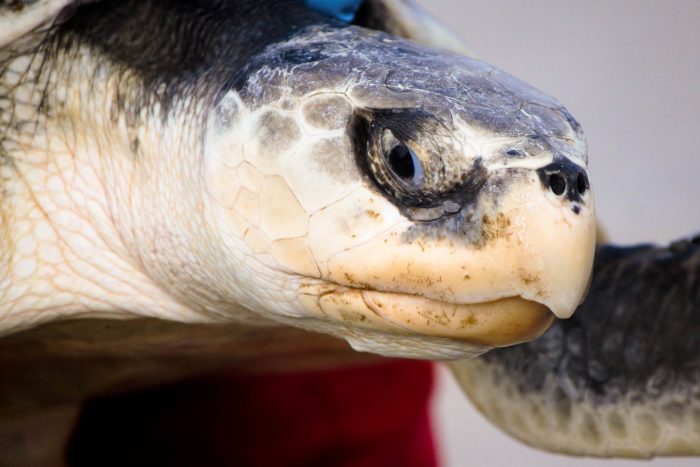Kemp's Ridley Sea Turtle
Lepidochelys kempii
Kemp’s ridley is a critically endangered sea turtle with creamy skin and grey or olive limbs. It feeds on blue crabs in the Chesapeake Bay in the summer.
This section shows one large critter image at a time. Use the thumbnails that follow to select a specific image to display here.

This gallery contains a grid of small thumbnails. Selecting a thumbnail will change the main image in the preceding section.
Appearance
The Kemp's ridley is the smallest sea turtle. Its carapace (shell) measures between 15 and 24 inches in length, and adults weigh between 75 and 100 pounds. It has an oval or heart shaped shell and one large claw on each fore-flipper. Its skin color ranges from creamy to white, and its head and limbs are gray or olive.
The tail of adult male Kemp's ridley sea turtles extends out longer than the tails of adult females. The eggs of Kemp's ridley sea turtles are perfectly round, with a leathery shell and are about the size of a ping pong ball. Hatchlings are solid grey-black, but as they grow into juveniles, the bottom shell turns white
Feeding
Kemp’s ridley sea turtles are opportunistic hunters, but their favorite food is blue crabs, as well as fish, sea urchins, squid and jellyfish. They have powerful jaws that help them to crush and grind crabs, clams, mussels and shrimp.
Predators
Hatchlings can be preyed upon by birds, mammals and crabs when they are crawling to the open ocean after emerging from their nests. The main threat facing Kemp’s ridley sea turtles, however, is human activity.
During the 1940s through the 1960s, large scale exploitation of eggs and meat occurred until the Mexican and Texas governments joined forces to protect the remaining population.
These turtles face many threats including:
- Poor fishing practices
- Propeller wounds
- Development of their key nesting beaches
- Entanglement in fishing gear,
- Dredges in the Gulf of Mexico and northwest Atlantic
Marine turtles also suffer from ocean pollution and marine debris. They can easily mistake fishing line, balloons, plastic bags, and other plastic debris for food.
Reproduction and life cycle
Kemp’s ridley sea turtles nest every one to three years, and lay an average of 110 eggs in each nest, laying two to three clutches each season. Their preferred nesting location is a beach with seasonal narrow connections to the open ocean. The nesting season for the Kemp’s ridley sea turtles runs from April to July.
Their nesting pattern is called arribadas, in which massive populations of turtles synchronize their nesting times and arrive together. Unlike other sea turtles, female Kemp’s ridley turtles nest in the daylight. The eggs incubate for about 55 days, until the hatchlings emerge and crawl toward the open ocean.
Hatchlings spend two to 10 years in an open ocean environment, traveling hundreds of miles until they reach sexual maturity and return to the same beach they hatched from.
Did you know?
- The Kemp's ridley was first document by a Florida fisherman and naturalist named Richard M. Kemp in 1880. To honor him, the species name became Lepidochelys kempii.
- Lepidochelys is derived from the Greek word “lepidos” which means "scale" and “chelys” which means "tortoise."
- Because of its long migration patterns, the Kemp's ridley sea turtle spends much of its life in isolation, and only socializes during mating and nesting.
- They are the second most common sea turtle in the Bay, with around 200 to 300 turtles visiting each summer to feed on crabs, mollusks and other crustaceans from May to November. This is the largest concentration of juvenile Ridleys in the world. They arrive as juveniles from their nesting site in the Gulf of Mexico, and travel to bays and estuaries around the coast.
- The temperature during incubation affects the sex ratio of the nest. Lower spring incubation temperatures tend to produce a large proportion of male babies.
Sources and additional information
- Kemp’s Ridley Sea Turtle — National Wildlife Federation
- Species Directory: Kemp's Ridley Turtle — NOAA Fisheries
- Kemp's Ridley Sea Turtle: Lepidochelys kempii — Virginia Herpetological Society
- Kemp’s Ridley Sea Turtle — Virginia Institute of Marine Science
